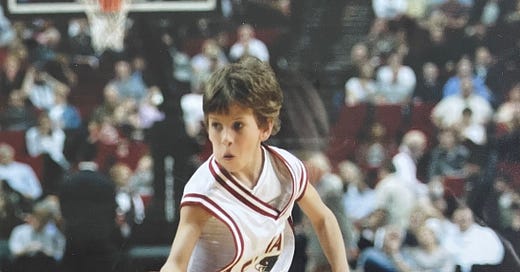The Tragedy of Gaming Alone. And, the Need for Team Sports.
Robert Putnam warned us that adults bowling alone was contributing to a fragmented society and a spike in loneliness. If we raise a generation to “game” alone, those trends will only worsen.
Few memories bring up as strong of emotions as thinking back on my time playing tournament basketball. I played on the same competitive basketball team from fourth grade through eighth grade. Our roster barely changed over those years, so I had a bench full of friends (especially because I spent my fair share of time on the bench). Our schedule took us to Canby and Camas, Beaverton and Battle Ground, and, during halftime of a Blazer game, even the Rose Quarter. I saw new parts of our state and played against kids of wildly different backgrounds.
David Jones coached that team. He managed to push each player to become far better on and off the court. Coach Jones refused to accept excuses. He also refused to let players think they weren’t capable of improvement. So we, the players, got better. And, we worked damn hard. Most importantly, we did all that growth, all that sweating, and all that conditioning as a team. When one of us showed up late, we all ran. When we won a tournament, we all celebrated together. When we lost, everyone came together to hear what could have gone differently.
The time I spent on Coach Jones’s team could not have come at a more pivotal time in my life. Just before joining the team, I had finally recovered from a year-long bout with anorexia. In that moment, I felt as isolated as one could be. I had spent days in the hospital, weeks in recovery, and months avoiding my friends. Coach Jones created a community and gave me a purpose that distracted me from the thoughts that had nearly destroyed me.
If I was at that same low point today, I’m not sure I would have managed to avoid relapsing into starving myself. Even in the years leading up to the pandemic, fewer and fewer kids were joining team sports. Nearly 50 percent of kids ages 6 to 12 played team sports in 2008. That number plummeted to just 38 percent in 2018. Today, in 2021, kids are signing up for e-sports leagues with their YMCA. There’s no team. No travel. No learning that you have an obligation to perform at your highest level for the betterment of all.
Not everything about team sports is positive. Even back when I was playing competitive youth sports in the late 2000s, things seemed out of control: uniforms were costly, tournaments were too long, and parents became too demanding. With the proliferation of social media and college recruiting seemingly taking place in Kindergarten, there’s a lot of negatives associated with the sports industrial complex.
As worried as I am about everyone forcing their kid to think they’re the next Damian Lillard (and forcing them to train like it), I am even more worried about a generation of kids growing up without knowing what it feels like to win (and lose) with a team.
Oregon is facing a huge wave of COVID cases that should not be taken lightly. This wave, though, cannot crash on the aspects of childhood that we know are essential to mental and physical development. Vaccine mandates for players and coaches should allow Oregon’s youngsters to get out of their video games and into real ones.
Robert Putnam warned us that adults bowling alone was contributing to a fragmented society and a spike in loneliness. If we raise a generation to “game” alone, those trends will only worsen.
Kevin Frazier edits The Oregon Way between classes at the UC Berkeley School of Law. He grew up in Washington County.
RELATED PIECES





